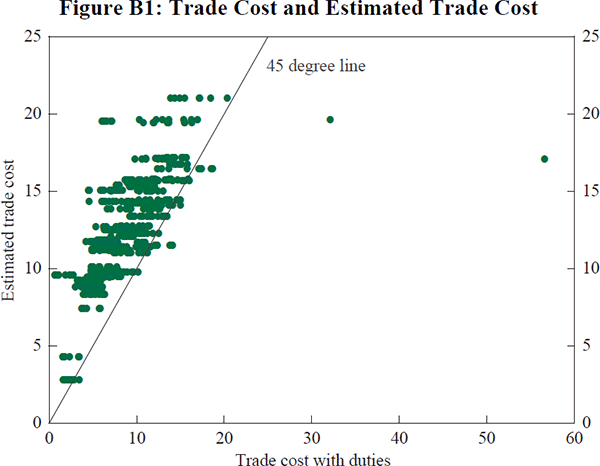RDP 2007-10: Trade Costs and Some Puzzles in International Macroeconomics Appendix B: Plausibility of Alternative Trade-cost Measure
October 2007
- Download the Paper 301KB
One way of checking the plausibility of the trade-cost estimates derived using equation (6) is to regress the beta estimates on distance and time and other variables that affect trade costs. The coefficient on distance from the US is expected to be positive. Another check is to see whether trade costs explain the extent of trade by running the regression:
where TradeUSit is bilateral trade between the US and country i at time t (from Glick and Rose 2002), X are the possibly relevant controls in gravity models (like distance and other terms capturing geography). If the betas are only capturing trade costs, it would be expected that the coefficient on the second term would be negative.
Figure B1 suggests that the estimated betas are generally similar to the more standard direct measure of trade costs. Table B1 provides further evidence that the betas plausibly capture trade costs. Panel A reports a large positive correlation between the direct measure of trade cost and the calculated estimate. It also reports a positive and significant relationship between the estimated beta and an observable related to trade costs (distance from the US). Panel B reports coefficients from a regression of the betas from Equation (6) on a range of variables common to gravity models of trade. It indicates that distance for the US and being an island is associated with higher betas, and a regional trade agreement (with the US) and having a common border (with the US) reduces beta. Sharing a common language with the US (i.e., speaking English) does not seem to have an effect on beta. Panel C indicates that the estimated betas are negatively related to the extent of trade with the US. (The results in Tables 9 and B1 are generally robust to the two potential outliers which can be seen in Figure B1.)

In summary, Figure B1 and Table B1 suggest that there is a reasonable relationship between the fitted measures of trade cost (beta) with both the actual money trade cost used in Section 3 and factors related to trade with the US, suggesting the betas are at least capturing factors related to US trade costs. To the extent that the US is a significant country in the world economy, trade costs with the US may be a good indicator of overall trade costs.
| Trade cost with duty | |
|---|---|
| Panel A | |
| Correlation between trade costs and betas | 0.69 |
| Coefficient from regressing beta on log of bilateral distance | 5.4* (0.4) |
| Panel B | |
| Regression of beta on multiple variables | |
| Log distance | 1.7 (0.9) |
| Common border | −5.4* (1.1) |
| Island | 1.5* (0.5) |
| Land-locked | −1.1* (0.3) |
| Common language | 0.1 (0.3) |
| Regional trade agreement | −2.6* (0.5) |
| Panel C | |
| Coefficient from regressing log(bilateral trade) on beta | −0.26 |
| Coefficient from regressing log(bilateral trade) on beta(a) | −0.78 |
| Notes: Robust standard errors in parentheses. The first-stage regression
(Equation (5)) was estimated using 113580 observations (where an observation
is a country-year-commodity type). The correlation in the top cell was
calculated from 588 observations (where an observation is a country-year).
* indicates significance at the 5 per cent level. (a) Additional controls are whether share border, whether an island, whether land-locked, whether share a common language, whether in a regional trade agreement, log distance, ‘decade’ dummies and the interaction between decade dummies and log distance. |
|
